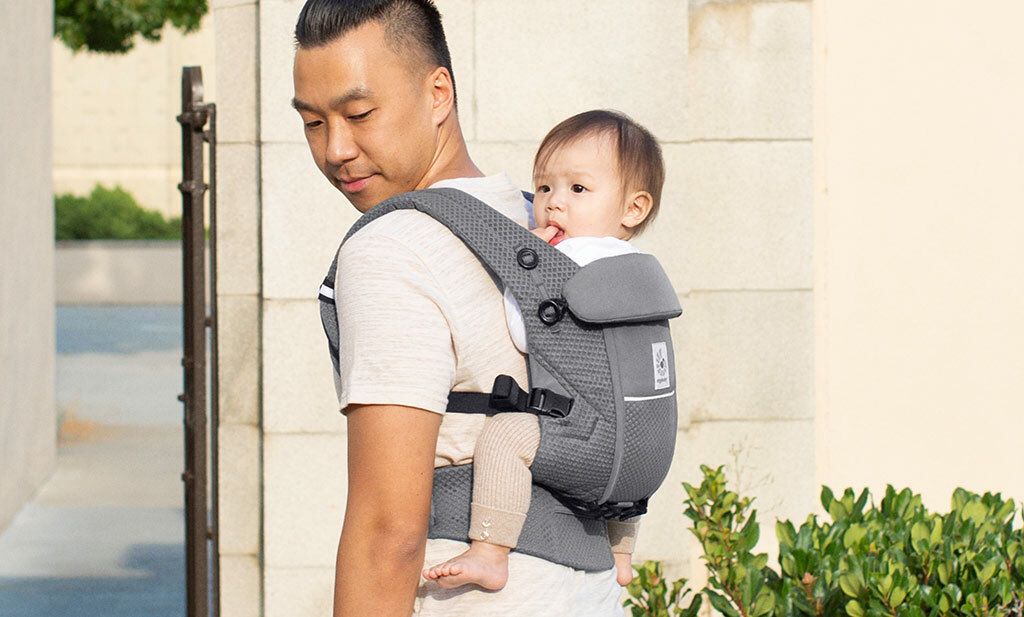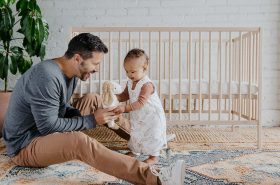
We love babywearing! It’s really in our DNA. Our founder Karin Frost designed her first baby carrier more than two decades ago as she simply couldn’t find anything satisfactory on the market at the time so ended up founding her own company. One of the things she made sure of is that Ergobaby carriers adapt with baby as they grow. And as your little love gets bigger there will come a time that they feel less comfortable on your front, at which point (and before if you like – as long as they reach all the steps listed below) we absolutely recommend trying a back carry in your Ergobaby carrier. It has lots of advantages and is expressly encouraged by our midwife and babywearing consultant Katrin Ritter.
When can I start carrying my baby on my back?
It is important that your little one has reached a minimum size and a certain stage of development before you can carry your baby on your back. They should have good head control, be able to sit upright unaided, and weigh at least 7.8kg. This is usually around five – six months old. Back carrying is a brilliant option if your little one has simply become too heavy to be carried on your front but still needs and wants to be close to your body. In these situations, back carrying is super practical. Baby feels safe and can enjoy being close to you while you have your hands and view free to get things done, e.g. doing housework, working on the computer (standing up), and much more. Hikes and long walks are in general much easier with baby in a back carry. This is because once your little one is a little bigger, it is difficult to keep an eye on obstacles such as tree roots, steps etc. while your baby is on your front. And above all, with an ergonomic baby carrier, the majority of your baby’s weight is taken off you, just like with a good hiking rucksack, so you can travel comfortably all day long.
Why is babywearing still important in toddlerhood?
Children go through half of their entire development in the first four years of their life! In that time (and all time!) they should be cared for in a way that is needs-oriented, sensitive and developmentally appropriate, by you and other close caregivers. And ergonomic babywearing with a baby carrier fulfils all of these requirements: it makes your everyday family life easier, promotes your child’s development and satisfies their basic needs for closeness, warmth and safety. It also strengthens your parent-child bond enormously, as we never tire of emphasising. No matter how big your not-so-little love is getting.
The other thing we talk about a lot is that babywearing – including carrying your baby or toddler on your back – promotes your child’s development. It activates and promotes balance, visual orientation via the eyes (as a motivator for movement and development), coordination plus foot and hand development. It helps to straighten the spine, stimulates symmetry (upright, centred posture), brings the shoulder and hip joints into a healthy position in the joint socket (squat-spread posture), regulates muscle tone and strengthens the muscles of your baby or toddler.
Children who have been carried a lot seem to have particularly good motor skills. Our expert Katrin has observed this in her previous work with young families. Because development always takes place through movement stimuli. And your little one gets this from being carried. Even when they are still in your womb. After birth, gravity comes into play. Carrying your baby upright strengthens the muscles and power in their torso meaning that learning to walk is also optimally supported by ergonomic carrying in a baby carrier. Alongside other movement activities beyond carrying, for example in a prone position (tummy time).
So babywearing is practically the gym for your little one. It works like a small “fitness studio”, but with certain advantages – namely the provision of security and love as well as freedom and flexibility for the parents. Paediatric physiotherapist Birgit Kienzle-Müller confirms this and summarises: “Babywearing is the development of movement and the basis of motor development. It is also an interaction between the wearer and the child.” And that’s true for a toddler as much as a baby!
Which baby carrier is the right one for a back carry?
First and most importantly, your baby carrier must fit. And that means both you and your baby. Because only if you all feel comfortable will you enjoy wearing it. A baby carrier should also grow with your little one and be adaptable to their age and development.
The machine-knitted Ergobaby Aerloom baby carrier, for example, adapts perfectly to every body shape. Almost tailor-made. It is lightweight and breathable and keeps your little one in an ergonomic position. You can use it for your baby or toddler up to a weight of 15.9 kg, i.e. up to around 3 years.
The Ergobaby Adapt and Ergobaby Omni also fulfil all of the above criteria and are ideal for carrying a baby on your back. Both models are available in breathable mesh material (Adapt SoftFlex™ Mesh or Omni Breeze) or as a cosy, soft cotton alternative (Adapt SoftTouch™ Cotton or Omni Dream). They are ready for use from birth (3.2 kg) and up to 20.4 kg. They both also have lumbar support waistbands and padded straps to comfortably distribute baby’s weight across your upper body, making them comfortable to carry even as they grow. The main difference between these two carrier models is that the Ergobaby Omni offers another position in addition to inwards facing, hip carry and back carry – outward facing.
The Ergobaby Away is also a suitable option because older toddlers can quickly find themselves in a situation where they are suddenly overcome by tiredness on outings and then want to be carried. It is super compact so can be popped in your handbag on any city trip or hiking excursion. So it’s always there when you need it and can give your little one (up to a weight of 15.9 kg) a well-deserved break when they need it.
Trying a back carry – practice makes perfect
Would you like to carry your toddler in a back carry in your Ergobaby carrier but don’t know how? Then watch one of our instruction videos, check out our Instagram, or get in touch with a sling library or babywearing consultant to show you how. It’s best to get someone to help you put your baby in the carrier at the beginning. But with a little practice, you should soon be able to do it on your own. And we have one last small but important tip for you: always keep an eye on your little one on your back. Use a small pocket mirror, for example, to regularly check their position and condition. For example, if your little one falls asleep, you might need to stabilise their head with the neck cushion (it can be folded up to the top buttons for extra support) or with the help of the hood (always make sure that little one has clear airways). Happy back carrying!



